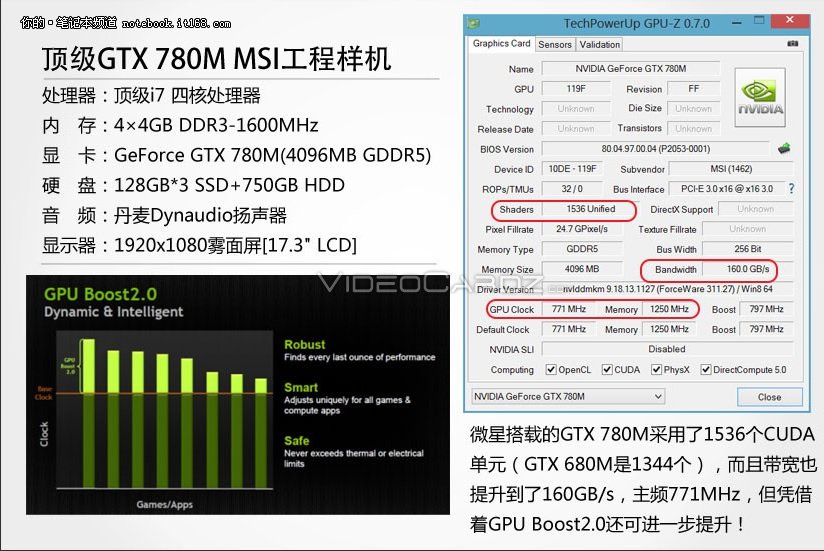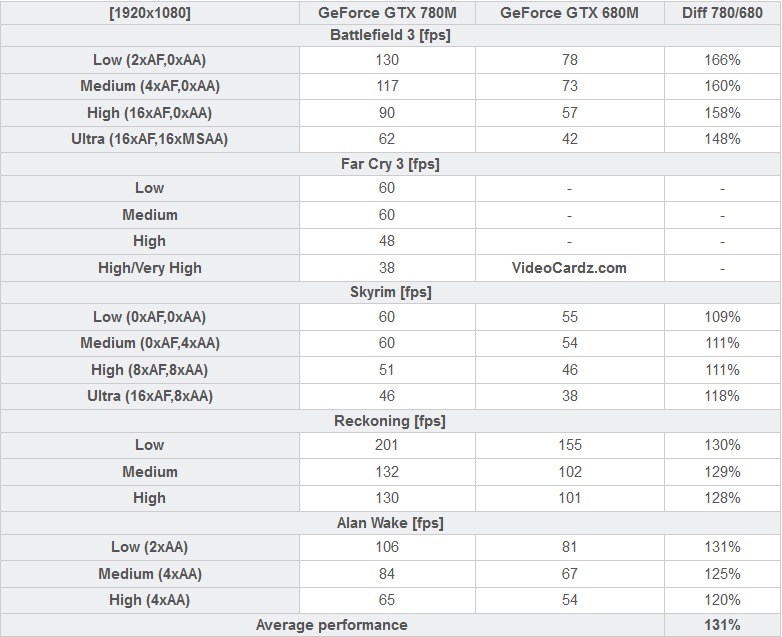Report: Nvidia GTX 780M Specifications Surface
The specifications of the GTX 780M have surfaced, and they are quite impressive.
While we've already shown you the specifications of a number of the upcoming 700-series graphics cards for desktops, we've shown you little about the mobile lineup. Hereby, we bring you the specifications of the GTX 780M, courtesy of VideoCardz.
Like the GTX 680M, the GTX 780M is based on the Kepler architecture. It features eight of the SMX units enabled, as compared to the seven that were enabled on the GTX 680M. Consequently, the card has 1536 CUDA cores running. This is the same number found on the desktop version of the GTX 680. Of course, though, the clock speeds are notably lower on the GTX 780M due to restrictions in heat production and power consumption for laptops and mobile devices. The core clock speed is at 771 MHz with a Boost speed of 797 MHz, featuring the newer Boost 2.0 technology.
Beyond the GPU core, we also see that the GTX 780M will carry 4 GB of GDDR5 memory, which will run at an effective speed of 6.00 GHz, and run over a 256-bit memory interface. This lets the card pump out 160 GB/s.
The folks at VideoCardz have also gotten some screenshots of the benchmarks; the average increase in performance (as compared to the GTX 680M) for the GTX 780M is a respectable 31 percent.
Get Tom's Hardware's best news and in-depth reviews, straight to your inbox.
Niels Broekhuijsen is a Contributing Writer for Tom's Hardware US. He reviews cases, water cooling and pc builds.
-
dragonsqrrl "Beyond the GPU core, we also see that the GTX 780M will carry 4 GB of GDDR5 memory, which will run at an effective speed of 6.00 GHz, and run over a 256-bit memory interface. This lets the card pump out 160 GB/s."Reply
I think 256-bit GDDR5 at 6 GHz equals 192 GBps of bandwidth. In other words the same memory bandwidth as the GTX680.
In any case the boost in memory bandwidth in itself should give mobile Kepler a healthy boost in performance. That really was the main thing holding back much of the 600m series. -
game junky Put one of those in next gen tablet PCs (a la Microsoft Surface Pro) with good battery management and I am intrigued.Reply -
Blazer1985 A card like this is already available and it is called 680mx.Reply
Just overclocked to 770mhz from original 720mhz of the 680mx.
But look at the 680m benchmarks on skyrim: 1080p LOW DETAILS 55 fps???
On a 486dx maybe.
Sorry Tom, specs might be true but I don't believe these benchmarks ^_^
-
dragonsqrrl Reply10804405 said:A card like this is already available and it is called 680mx.
Just overclocked to 770mhz from original 720mhz of the 680mx.
Not quite. First the mx is only available in certain iMac's. It has a 5 GHz memory clock as opposed to the rumored 6 GHz clock on the 780m. And don't underestimate the effectiveness of GPU boost 2.0, it's much better at sustaining boost clocks than the original. And this isn't mentioned anywhere in the article, but I wouldn't be surprised if the 780m uses the upcoming gk104 revision that will probably show up first in the GTX770. From what I've heard it should provide slightly improved power efficiency and thermals over current silicon. -
dragonsqrrl Reply10804320 said:Put one of those in next gen tablet PCs (a la Microsoft Surface Pro) with good battery management and I am intrigued.
I don't think that's a reasonable expectation for a dGPU targeted at high-end gaming laptops. -
edgewood112358 <quote>Reply
Put one of those in next gen tablet PCs (a la Microsoft Surface Pro) with good battery management and I am intrigued.
</quote>
The GTX 780m is NEVER going in a tablet. This thing is going to, in all likelihood have a TDP north of 100 watts, since that's what the 680M is rated at and this thing has more on die resources. Not only does that mean that the tablet would have to dissipate that much heat, but the GPU alone could drain the battery of the surface Pro (42 watt hours) in well under 30 minutes, not to mention the impact of the rest of the system. -
themissingpiece I believe the original GTX 680M was Fermi-based. The 680MX, on the other hand,was Kepler based.Reply -
Blazer1985 Nope, 675m is an overclocked 580m (fermi based) while 675mx and 680m are kepler based :-)Reply -
tigger888 Turns out that gtx 770 is a bios flashed 680. (check reddit)Reply
The 780 looks to be a castrated gtx titan.


